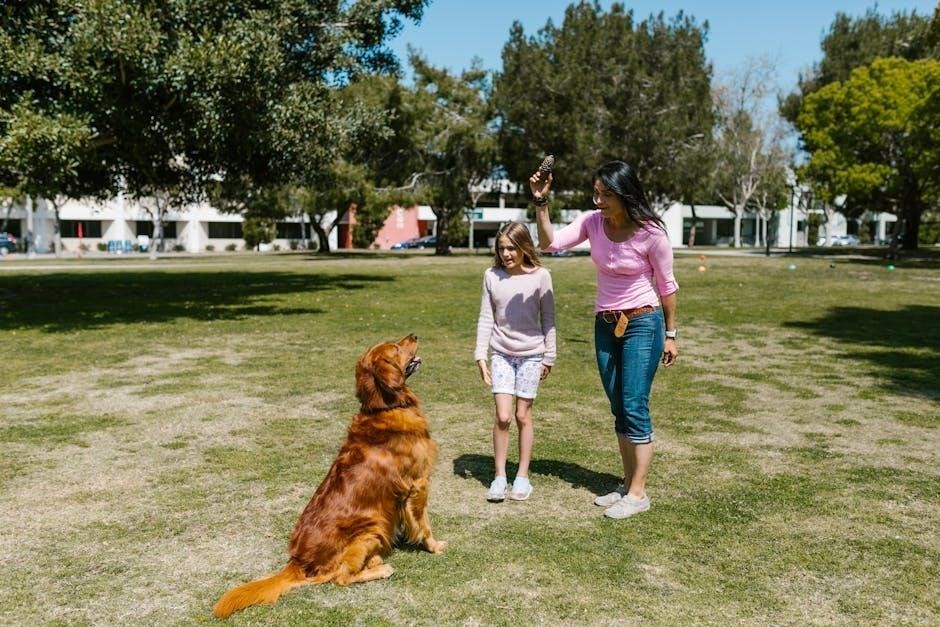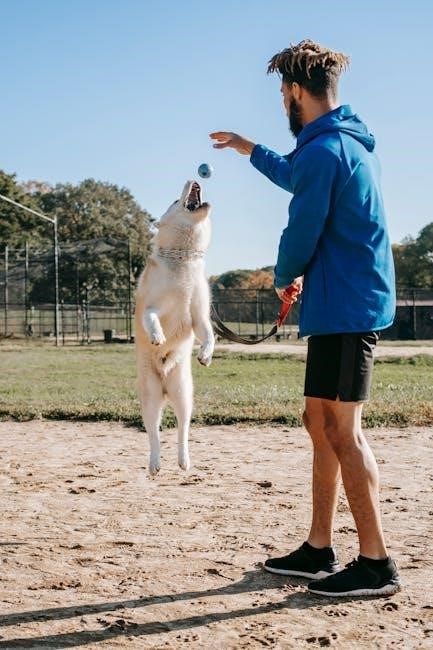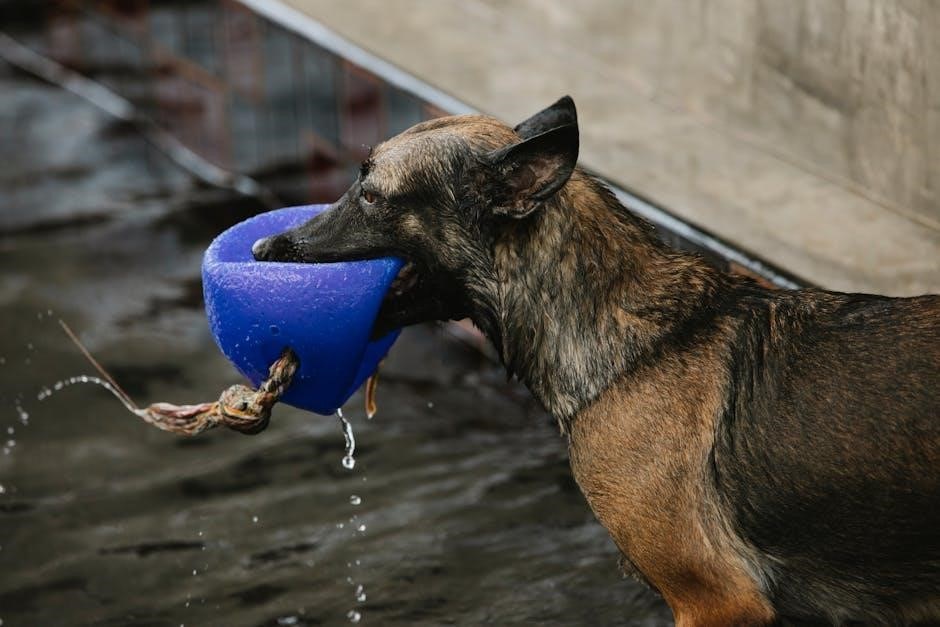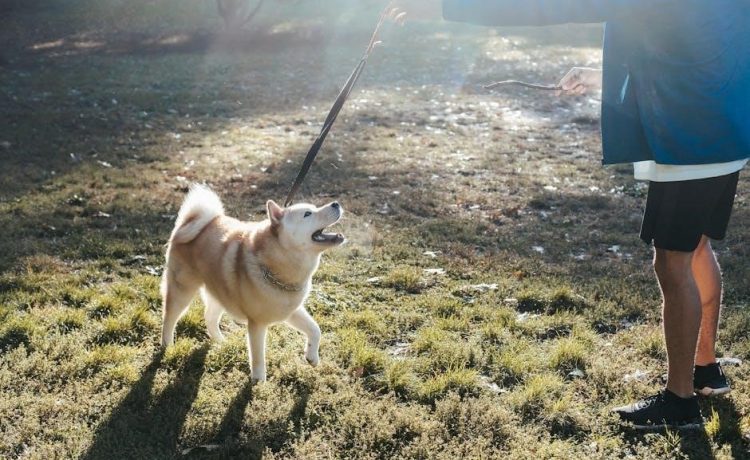This comprehensive guide provides a detailed approach to dog training, covering essential commands, positive reinforcement, and advanced techniques. Perfect for both new and experienced trainers, it serves as a solid foundation for understanding canine behavior and improving communication with your pet.
1.1 Importance of Dog Training
Dog training is essential for establishing a strong bond between you and your pet. It enhances safety, teaches social skills, and provides mental stimulation. A well-trained dog is calmer, more obedient, and better behaved in public. Training also helps prevent behavioral issues and strengthens communication. By investing time in training, you create a disciplined and respectful relationship, ensuring a happier, healthier life for your dog.
1.2 Benefits of Using PDF Resources
PDF resources offer a structured and accessible approach to dog training. They provide detailed guides, step-by-step instructions, and visual aids, making complex techniques easier to understand. Portable and printable, PDFs allow trainers to access information anywhere, ensuring consistency in lessons. Many resources include optional exercises and comprehensive lesson progressions, catering to both basic and advanced training needs. This format supports systematic learning, helping trainers and dogs progress effectively. PDFs are a valuable tool for modern dog training, offering convenience and clarity for successful outcomes.

Basic Obedience Commands
Mastering basic commands like “sit,” “stay,” and “come” is essential for establishing a strong foundation in dog training. These commands help create structure and improve communication with your pet, ensuring a well-behaved and responsive companion in daily life.
2.1 Teaching Sit, Stay, and Come
Teaching basic commands like “sit,” “stay,” and “come” forms the cornerstone of effective dog training. Start with “sit” by holding a treat above your dog’s head and moving it backward toward their tail. As they follow the treat with their nose, their bottom will lower into a sitting position. Reward immediately with the treat and praise. For “stay,” begin with your dog in a sitting position, take a few steps back, and return to reward them for remaining still. Gradually increase distance and duration. “Come” should be practiced in open areas, using positive reinforcement to encourage your dog to return promptly. Consistency and clear instructions are key to mastering these commands, which are essential for daily interactions and more advanced training.
2.2 Effective Use of Commands in Daily Life
Mastering basic commands enhances your dog’s behavior in everyday situations. Use “sit” before meals or walks to ensure calmness. “Stay” helps in maintaining control, such as when opening doors or during walks. “Come” is crucial for emergencies, ensuring your dog returns promptly. Consistency is key; involve all family members in practicing these commands. Positive reinforcement, like treats or praise, encourages obedience. Place treats by entry doors for greeting routines. These commands create a structured environment, making daily interactions smoother and strengthening your bond with your dog.

Positive Reinforcement Techniques
Positive reinforcement focuses on rewarding desired behaviors with treats, praise, or affection. This method encourages good conduct, strengthens your bond, and fosters a confident, eager learner. Treats can gradually be replaced with affection as training progresses, maintaining motivation without over-relying on food rewards. Consistency and patience are key to achieving lasting results and helping your dog understand expectations clearly. This approach creates a positive, enjoyable learning environment for both you and your pet.
3.1 Using Treats and Praise Effectively
Using treats and praise is a cornerstone of positive reinforcement training. Treats serve as tangible rewards for desired behaviors, immediately reinforcing actions like sitting or staying. Praise, such as verbal encouragement, complements treats, creating a positive emotional connection. It’s important to use high-value treats initially to capture your dog’s attention, then gradually phase them out as behaviors become ingrained. Timing is crucial—rewards should follow actions instantly to ensure understanding. This dual approach keeps training sessions engaging and effective, fostering a motivated and responsive learner. Consistency in reward delivery helps build trust and accelerates the learning process.
3.2 Transitioning from Treats to Affection
As your dog becomes more reliable with commands, it’s essential to gradually phase out treats and introduce affection as a reward. Start by substituting treats with praise, such as saying “good boy” or “well done,” and incorporate physical affection like pats or cuddles. This transition strengthens the emotional bond and teaches your dog to respond to non-tangible rewards. Timing is crucial—ensure your dog associates the praise with the desired behavior. Consistency and patience during this process will help your dog understand that your approval is just as rewarding as treats, fostering a deeper connection and motivation to please.

Advanced Training Methods
Optional exercises enhance skill development, while step-by-step lesson progression ensures a smooth transition from basic to complex tasks, refining your dog’s abilities effectively.
4.1 Optional Exercises for Skill Enhancement
Optional exercises offer tailored activities to refine your dog’s abilities, ensuring a challenging yet engaging experience. These exercises can include agility drills, scent work, or complex command sequences, designed to stimulate both physical and mental growth. By incorporating these optional tasks, you can address your dog’s specific needs and interests, fostering a deeper understanding of their capabilities. Each exercise builds on previously learned skills, creating a progressive learning curve that keeps your dog motivated and eager to learn. This approach allows for a personalized training plan that enhances overall performance and strengthens the bond between you and your pet.
4.2 Step-by-Step Lesson Progression
A well-structured training program follows a step-by-step approach, ensuring your dog builds skills gradually. Each lesson is designed to reinforce previous learning while introducing new challenges. This method prevents overwhelming your dog and helps maintain focus. Start with simple commands, then progress to more complex tasks. Positive reinforcement techniques, such as treats and praise, are integral at every stage. Consistency is key to fostering confidence and understanding. By following this progression, you create a clear learning path that keeps your dog engaged and motivated, ensuring long-term success in their training journey.

Common Misconceptions in Dog Training
This section debunks the flawed alpha approach and explains why punishment should be avoided, promoting positive reinforcement for effective dog training.
5.1 The Flawed Alpha Approach
The “alpha approach” to dog training is widely misunderstood and outdated. Dominance theories suggest dogs aim to lead, but this misinterprets canine behavior. Dogs thrive on clear boundaries, not hierarchical struggles. Punishing or asserting dominance can harm trust and lead to fear or aggression. Instead, focus on positive reinforcement and mutual respect. Building a strong bond based on communication and consistency is far more effective. This section explores why the alpha approach is flawed and how modern techniques prioritize understanding and empathy for better training outcomes.
5.2 Why Punishment Should Be Avoided
Punishment in dog training can lead to fear, anxiety, and mistrust, damaging the relationship between dog and owner. It often suppresses behavior temporarily without addressing the root cause, potentially causing long-term emotional harm. Dogs may associate punishment with unrelated actions, leading to confusion and unintended consequences. Positive reinforcement, focusing on rewards and consistency, is a more effective and humane approach. This method encourages desired behaviors while fostering trust and confidence. Avoiding punishment ensures a healthier, more respectful training environment, leading to better outcomes for both the dog and the trainer.

Specialized Training Topics
This section explores advanced training methods tailored to specific needs, such as addressing behavioral challenges and utilizing homemade treats for effective, personalized dog training experiences.
6.1 Addressing Specific Behavioral Needs
Behavioral issues like aggression or anxiety require tailored strategies. Positive reinforcement techniques, consistency, and patience are key. Professional guidance can help identify root causes and customize training plans. Implementing gradual exposure and desensitization methods can effectively address these challenges. Homemade treats and clear communication strengthen the bond, ensuring a balanced approach to overcoming specific behavioral needs.
6.2 Homemade Treats for Training
Homemade treats are a great way to reward your dog during training. They offer health benefits and cost-effectiveness. Use simple, wholesome ingredients like oats, peanut butter, and bananas to create tasty rewards. Avoid additives and focus on natural flavors to ensure your dog’s safety and preference. These treats can be customized to suit your dog’s dietary needs, making them ideal for training sessions. By using homemade options, you can maintain your dog’s interest and motivation while keeping their diet balanced.

The Role of Technology in Training
Technology enhances dog training through innovative tools and methods. Machine learning and AI applications create personalized training plans, improving efficiency and effectiveness for dog owners and trainers alike.
7.1 Machine Learning Applications
Machine learning plays a transformative role in dog training by enabling personalized, adaptive training plans. By analyzing a dog’s behavior, learning pace, and responses, ML algorithms create tailored exercises. For example, machine learning can detect early signs of anxiety or aggression, allowing trainers to intervene effectively; Apps powered by ML adjust command difficulty based on performance, ensuring progressive learning. Real-time feedback tools enhance training accuracy, helping owners refine their techniques. This technology not only improves training efficiency but also deepens the bond between dogs and their owners, making it a powerful tool for modern pet care.
7.2 AI in Modern Dog Training Methods
AI enhances dog training by offering real-time feedback and customized training plans. AI-powered tools analyze a dog’s behavior, adapting exercises to suit their learning pace and temperament. For instance, AI can detect early signs of anxiety or aggression, recommending tailored strategies. Apps equipped with AI simulate training scenarios, helping owners practice consistency. Additionally, AI-driven devices monitor progress, providing insights to refine techniques. This technology not only streamlines the training process but also fosters a more intuitive and effective approach, making it easier for owners to achieve their training goals and strengthen their bond with their pets.
Involving the Whole Family
Families can enhance training by participating together, ensuring consistency and strengthening bonds with their dog. Shared involvement creates a unified approach, benefiting both the dog and household.
8.1 Engaging All Household Members
Engaging all household members in dog training fosters a united approach and strengthens the bond between the dog and the family. Assign age-appropriate tasks to children, such as feeding or short training sessions, while adults can handle complex commands. Encourage open communication to ensure consistency in commands and rewards. Shared responsibilities create a cohesive environment, helping the dog understand expectations clearly. This collective effort not only enhances training effectiveness but also deepens the connection between the dog and every family member, making the process enjoyable and rewarding for all involved.
8.2 Consistency in Family Training Efforts
Consistency is key to successful dog training within a family. When all members use the same commands and techniques, the dog learns more efficiently. Establishing a routine ensures that training doesn’t become confusing for the dog. Regular family meetings to discuss progress and challenges can help maintain uniformity. By aligning expectations and methods, the family creates a stable learning environment. This consistency not only accelerates the dog’s understanding but also strengthens the bond between the dog and each family member, leading to better overall behavior and a more harmonious household;
